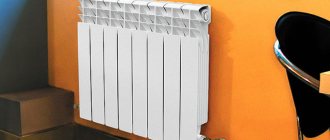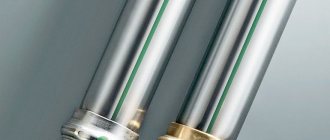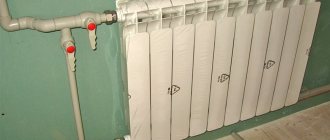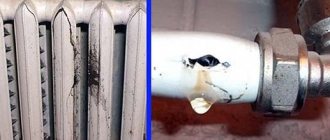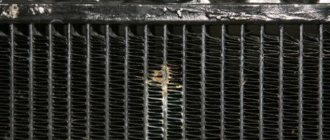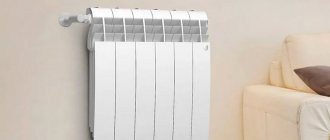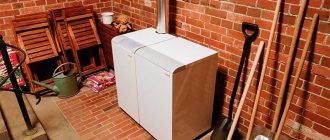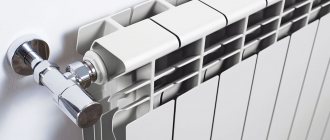It often happens that instead of antifreeze for aluminum car radiators, owners fill them with ordinary water. As a result, such actions cause serious harm to transport, reduce the service life of equipment and do not protect against corrosion at all. When I asked motorists why they didn’t buy antifreeze, I learned that they were simply afraid of harming the aluminum engine.
In fact, it is enough to know how to choose antifreeze so as not to harm the car. The choice should be based on which product is the underlying refrigerant. Today there are a lot of different coolers, so let's figure out which compositions are best suited.
Types of coolant
Water is the most popular and accessible coolant for water heating circuits. However, due to its use as a coolant for aluminum heating radiators, the metal begins to rust, and scale and deposits appear inside the pipes. Therefore, such systems require periodic flushing and cleaning. Also, during winter shutdowns, there is a real danger of freezing: in such cases, it is necessary to drain the water. If this is not done, freezing of the liquid will certainly lead to rupture of pipes and batteries.
All this indicates that, in addition to correctly calculating the power of the batteries for the room, it is important to use exactly the coolant that is not afraid of freezing and chemical interaction with metal walls. It is important to keep in mind that such special solutions do not have a negative impact on human health when the circuit leaks.
We are talking about antifreeze: this coolant is not afraid of low temperatures, which is facilitated by additives and additives dissolved in the liquid, which act as inhibitors of corrosion and mineral deposits.
Historical excursion
To begin with, I’ll briefly talk about the history of engine building. The first motors were designed and implemented about two hundred years ago. Previously, there were no antifreezes, and they had not yet figured out how to use water as a coolant. As a result, the engine was cooled naturally - using air.
Literally a few years later, a water-cooled motor appeared, which subsequently began to be actively introduced. The first antifreezes were developed only in the 19th century, and were produced in the form of layered, alcohol or glycerin (with the addition of sugar and honey) formulations. Only at the beginning of the 20th century did substances protect internal combustion engines from the negative effects of corrosion go on sale.
Types of coolants
The most common coolant in centralized and autonomous heating systems is water. Its popularity is explained by its general availability, low cost, environmental safety, and good thermal characteristics. However, there are also a number of significant disadvantages.
The presence of dissolved salts in water leads to the formation of scale on the internal walls of radiators. As a result, heat transfer is significantly reduced, the flow diameter of radiators is reduced, which impairs coolant circulation.
Another disadvantage is the rather high freezing point of water (0 °C). Freezing water leads to the destruction of radiators. Therefore, if interruptions in the operation of the system are possible, it is recommended to use a non-freezing coolant for heating radiators - antifreeze.
The freezing point of antifreeze can reach -65 °C. This is enough to operate the heating system in almost any conditions. In addition, even when frozen, it turns into a gel-like state, which does not lead to destructive consequences for radiators.
The operating temperature of antifreeze is about +75 °C, which is also quite consistent with the parameters of most heating systems. The use of antifreeze has a beneficial effect on the service life of gaskets, seals and other non-metallic elements of the system.
Today, antifreezes based on ethylene glycol and propylene glycol are most often used in heating systems. Ethylene glycol has optimal thermophysical characteristics, but is a strong toxin. Therefore, antifreezes based on propylene glycol, which is a harmless substance, are most widely used.
When using antifreeze, it is very important to control its acidity level. For most radiators, a pH level of 7-8 is recommended
If it is exceeded, the metal of the radiator can quickly corrode.
I have Fill for Life antifreeze, which means I don’t need to change it!
Fill for Life - means for the entire service life... of the unit that uses this consumable. A little trick. Modern engines, radiators, pumps and turbines rarely run more than 150–200 thousand km. And this is exactly the period that high-quality carboxylate or lobride antifreeze should last.
When it comes to “homemade” antifreezes (not to mention methanol mixtures), 250,000 km or even more written on the label is just a figment of the imagination of marketers. After all, in order to confirm the declared mileage, antifreeze must pass a number of complex tests from automakers, tests according to international standards (for example, ASTM 6210).
In general, if you have original antifreeze or its rebrand, then yes - until any element of the cooling system is repaired, the antifreeze will work as it should. But this rule does not apply as soon as it comes to, for example, “Russian” developments that do not have test results officially confirmed by automakers.
Some coolant features
It is important to remember that it is not recommended to use antifreeze in radiators where zinc is present. It is not recommended to use antifreeze in aluminum heating circuits containing copper or brass.
Its reaction with these metals can cause an electrolytic reaction
It is not recommended to use antifreeze in aluminum heating circuits containing copper or brass. Its reaction with these metals can cause an electrolytic reaction.
When using antifreeze, you should use polymer rather than rubber seals as gaskets between radiator sections.
Antifreeze must also be used in circuits that have more than one section, because this coolant has a low heat capacity, and therefore it needs more space.
When choosing a coolant, you should decide on the required volume of solution, the power of the boiler and circulation pump, and you also need to carefully check the general condition of the heating system before filling it.
The use of antifreeze in aluminum heating radiators has a number of positive aspects compared to other types of fillers. Thanks to the use of antifreeze, the heating circuit will last a long time and will consistently provide the required level of heat.
You can find out what is better to fill the heating system with water or antifreeze from the video below.
How to choose a suitable cooler for an aluminum engine?
It is important to choose the right product for your vehicle. Filling with harmful coolant can lead to engine malfunction and even deformation. There are a number of tips that will allow you to buy a product that meets all the characteristics:
- Many refrigerants have different shades. Often, the color scheme corresponds to the class of liquid. G 11 is characterized by green and blue colors; for G 12, 12+ and 12++, manufacturers choose red, orange, and sometimes green tints. G 13 - predominantly red, sometimes purple, lilac.
- It is important to study the composition of the product. For aluminum motors, it is worth choosing a minimally toxic product.
- It is necessary to take into account what is added to antifreeze as additives.
It is imperative to make sure that the substances sold in the store are original. To do this, you need to carefully inspect the canister and ask the seller for a quality certificate.
Types and properties of heat-carrying liquids
The working fluid of any water system - the coolant - is a liquid that takes a certain amount of energy from the boiler and transfers it through pipes to heating devices - radiators or underfloor heating circuits. Conclusion: the efficiency of heating depends on the physical properties of the liquid mediator - heat capacity, density, fluidity, and so on.
In 95% of private houses, ordinary or treated water is used with a heat capacity of 4.18 kJ/kg•°C (in other units - 1.16 W/kg•°C, 1 kcal/kg•°C), which freezes at a temperature of about zero degrees. The advantages of traditional heating fluid are availability and low price, the main disadvantage is the increase in volume when frozen.
Crystallization of water is accompanied by expansion; cast iron radiators and metal-plastic pipelines are equally destroyed by ice pressure
The ice that forms in the cold literally splits pipes, boiler heat exchangers and radiators. To prevent the destruction of expensive equipment due to defrosting, 3 types of antifreeze made on the basis of polyhydric alcohols are poured into the system:
- Glycerin solution is the oldest type of non-freezing coolant. Pure glycerin is a transparent liquid of high viscosity, the density of the substance is 1261 kg/m³.
- An aqueous solution of ethylene glycol - dihydric alcohol with a density of 1113 kg/m³. The starting liquid is colorless and is inferior in viscosity to glycerin. The substance is toxic, the lethal dose of dissolved glycol when taken orally is about 100 ml.
- The same, based on propylene glycol - a transparent liquid with a density of 1036 kg/m³.
- Compositions based on the natural mineral - bischofite. We will analyze the characteristics and features of this chemical separately (below in the text).
Anti-freeze products are sold in two forms: ready-made solutions designed for a certain subzero temperature (usually -30 ° C), or concentrates, which the user dilutes with water himself. Let us list the properties of glycol antifreezes that affect the operation of heating networks:
- Low crystallization temperature. Depending on the concentration of polyhydric alcohol in an aqueous solution, the liquid begins to freeze at a temperature of minus 10...40 degrees. The concentrate crystallizes at 65 °C below zero.
- High kinematic viscosity. Example: for water this parameter is 0.01012 cm²/s, for propylene glycol - 0.054 cm²/s, the difference is 5 times.
- Increased fluidity and penetrating ability.
- The heat capacity of non-freezing solutions lies in the range of 0.8...0.9 kcal/kg °C (depending on concentration). On average, this parameter is 15% lower than that of water.
- Aggressiveness towards some metals, such as zinc.
- The substance foams when heated and quickly decomposes when boiling.
Propylene glycol antifreeze is usually colored green, and the prefix “ECO” is added to the marking.
In order for antifreezes to meet operational requirements, manufacturers add additive packages to glycol solutions - corrosion inhibitors and other elements that maintain antifreeze stability and reduce foaming.
Bimetallic heating radiators
Bimetallic heating radiators, as the name implies, consist of two metals and combine their best properties.
As a rule, they have a steel core, which allows them to withstand high pressure, as well as an aluminum shell, which has high heat transfer.
Can be installed in a central heating system.
Such bimetallic batteries have a modern design, quickly heat up and cool down, and have high efficiency.
In appearance they are not much different from aluminum radiators.
Advantages of bimetallic radiators:
- high heat transfer;
- withstands high pressure;
- modern design;
- greater reliability;
Calculation of heating radiators
In order to correctly calculate the number of required sections, you need to know some reference data. These data show how much heat needs to be spent to keep the room warm. All values are given for an area of 10 m2.
- For a panel house you need 1.7 kW;
- For a brick house 1 kW;
- For corner rooms, we multiply this data by a factor of 1.2.
Now you can easily calculate the required number of heating radiator sections.
Example: Room 15 m2, corner, brick house. We divide the area of 15 m2 by the estimated area of 10 m2 and multiply by 1 kW.
15m 2 /10m 2 *1kW=1.5 kW.
Because We have a corner room, then this value must be multiplied by a factor of 1.2. We find that to heat such a room, 1.8 kW of heat is needed. Then you need to select the required heating radiator. This data must be contained in the battery data sheet. Here are just some approximate capacities for various radiators.
- cast iron - 160 W one section;
- aluminum - 190 W one section;
- steel - 450-5700 W for the entire panel;
- bimetallic - 200 W one section.
It turns out that if you decided on bimetallic heating radiators, then you will need 1.8 kW/0.2 kW=9 sections. Take more stock in one section because... It is easier to reduce the temperature in the room than to install an additional section.
What to put in the heating system
This question arises only for private developers, because only they have a choice. What is better to fill with water or antifreeze depends on the boiler and pumping equipment, heat exchangers, heating pipes, etc.
Water is the cheapest and most accessible liquid. It is used for heating in private and multi-storey construction, but it has a number of disadvantages.
It must be operated at positive temperatures. When freezing, a breakdown of pipes, boiler, etc. may occur, which will lead to failure of the entire heating system. Therefore, if you turn off the heating of the house, you will have to drain all the water from the system.
The water used for heating is usually not distilled and has many different impurities. When heated, various chemical reactions occur, which leads to the appearance of salts on the inner surface of pipes and heating radiators. As a result, efficiency is lost and efficiency decreases.
In heating where water is used, any type of radiator can be installed : cast iron, aluminum, steel, bimetallic .
The main property of antifreeze is freezing at lower temperatures compared to water. The service life is about 10 heating seasons, after which it is better to replace it.
With such heating, elements containing zinc cannot be used, because it will disintegrate and settle on the inner walls of pipes, boilers, batteries, etc.
Let us remind you once again that if you use antifreeze, it is better not to install aluminum heating radiators, but instead purchase steel or bimetallic heating radiators; you can, of course, use cast iron ones, but they are increasingly becoming a thing of the past.
Quite often, many owners of autonomous aluminum radiators use ordinary water to fill them. This negatively affects the operation of the heating circuit, reduces its service life, promotes corrosion, and ultimately disables the system. Today, you can use many other liquids designed specifically for use in radiators. The most common of these is antifreeze.
Advantages of radiators with antifreeze
If you fulfill all the above requirements, then:
- A radiator with antifreeze will last 10 years or more.
- It is environmentally friendly and harmless to human health.
- A huge selection of aluminum radiators suitable for filling with antifreeze.
- High-quality antifreeze from the manufacturer (well-known brands), in a large assortment.
- Indispensable in schools, hospitals and residential premises in case of sudden power outage or gas supply.
Bimetallic heating radiators Flat heating radiators Heating radiators or heated floors Heating radiators with bottom connection
How to fill coolant into an aluminum radiator?
Typically, many heating systems are made specifically taking into account the further use of antifreeze in them. The power of the boilers and the materials used in the system itself are planned. But this doesn't always happen. A situation often arises when you need to pour a special coolant into a radiator that previously used water. In this case, some recalculations related to the boiler power should be made.
And it is also strongly recommended that the pipes be thoroughly cleaned or completely replaced.
Advantages and disadvantages
When choosing antifreeze to fill into a radiator, you should select a special composition intended for these purposes. Antifreeze refers to a special liquid that does not freeze at low temperatures. Special solutions for heating circuits contain special impurities and additives that do not harm the radiator and maintain its stable operation.
Among the negative aspects of antifreeze, several factors can be noted.
The thermal capacity of antifreeze is low. Such liquids are 115% inferior to water in this indicator. To use this coolant in a radiator, a special pump is required to start the entire system, since fluids for heating circuits have a high viscosity. Therefore, they must be accelerated by a pump for the system to start working. Antifreeze has high fluidity
For this reason, special attention should be paid to welds and connections on the radiator. Some compounds are extremely toxic and harmful to human health.
But despite the above-mentioned disadvantages of this type of coolant, it is perfect for use in aluminum circuits with an autonomous heating system.
The most popular brands of refrigerants
Today there are several brands that deserve attention from drivers. The following companies produce good auto chemicals for aluminum engines:
- "Tosol-Sintez" A Russian company that produces antifreezes of the popular Felix line. There are four types of compounds that have different properties.
- Liqui Moly. German manufacturer. The compositions from this company are very high quality and today are among the leaders in sales.
- Motul. A French company that pays special attention to the biological safety of materials and the complete safety of users.
- "Obninskorgsintez" A Russian brand engaged in the development and production of Sintec antifreeze.
Various antifreezes are popular in Russia. In addition to these, we can also highlight Long Life and Nord.
Benefits of ethylene glycol antifreeze
How do antifreezes differ in general? They do not freeze at fairly low temperatures. Pure ethylene glycol is a viscous, oily, colorless liquid with little odor. Its boiling point is +197 and its freezing point is -13 degrees Celsius.
But in a dacha that is closed for the winter, the room temperature can be much lower.
In order to prevent the ethylene glycol concentrate from freezing and causing the heating system to fail, it is diluted with water and a solution is obtained, the freezing point of which can be as low as -70 degrees Celsius.
For the production of coolants, not only ethylene glycol, but also propylene glycol is used, but the latter ingredient has the highest viscosity, and therefore the highest density.
And according to the laws of physics, it will have the highest freezing temperature. That’s why experts often recommend the antifreeze composition G11 G12 based on ethylene glycol.
All about coolant (Antifreeze)
Along with motor oil and fuel, antifreeze is one of the most important auto fluids that ensure engine operation. A good antifreeze maintains the engine temperature at which all processes proceed optimally.
In fact, antifreeze is one of the components of the coolant (coolant) that is poured into the cooling system.
Why do you need coolant?
The first function is clear without explanation: to cool a running engine to an acceptable temperature at which both engine oil and metal operate in the least wear mode.
The second task of the cooling system is to help warm up the engine from the moment it starts. Working “cold” does not benefit the engine, and the coolant circulating in its jacket helps to quickly and evenly warm up all parts of the engine to the desired temperature (approximately 80-90°C). The thermostat helps automatic adjustment: until the temperature in the cooling system rises to the desired level, the antifreeze will not cool.
In the winter season, the car interior is heated with excess heat from the engine: antifreeze is sent to the heater radiator and releases heat to warm passengers.
Antifreeze requirements
In addition to its “direct responsibilities,” antifreeze performs several more functions: it protects metal parts of the cooling system from corrosion, and rubber parts from degradation, maintains fluidity at low temperatures, does not foam and does not form scale and sediment on metal surfaces.
The result is a sometimes contradictory set of requirements: low freezing point and high boiling point, inertness towards metal and plastic, fluidity and minimal foaming, high heat capacity, resistance to high temperatures and low price.
In addition, even frozen antifreeze should increase in volume minimally so as not to damage the cooling system.
Taking into account all these requirements, different formulations of coolants were developed, which today have come to a certain unified standard. High-quality antifreezes fulfill all the requirements placed on them, which are becoming more stringent every year.
Composition and specification
Modern coolants consist of 90% a mixture of equal parts water and antifreeze itself. As a rule, the active component is ethylene glycol, and in the most expensive ones - propylene glycol. The developers came to the conclusion that it is the proportion of 60:40 or 50:50 that provides optimal performance in terms of consumer properties and price of the finished product. And 10% is a package of additives that determine how high quality the final liquid will be. Each manufacturer has its own additive formula that provides the same anti-corrosion, anti-foam, anti-scale, anti-cavitation and other properties.
A mixture of ethylene glycol and water has the important property of not freezing immediately: at low temperatures, small crystals form in the liquid, which become more and more numerous as it cools, but the mixture remains semi-liquid. And only when cooled below 70°C does the mixture completely freeze. This property allows you to select antifreeze depending on the climate, and the cooling system will work in any weather. The specification of coolants was developed by the Volkswagen concern, and this system most fully characterizes their quality and composition. When purchasing, you can rely on these standard designations.
Antifreezes are divided according to their composition depending on the additives they contain.
- Traditional (Traditional, Conventional, IAT) are outdated fluids made on the basis of inorganic additives: phosphates, silicates, nitrates, amines, borates, benzoates and others. European manufacturers stopped producing such products back in the 90s, but today you can find numerous “Antifreezes” on the market, which relate specifically to traditional antifreezes. It is undesirable to use them in modern cars: no one can predict how outdated antifreeze will behave when in contact with modern rubber gaskets and seals.
- Hybrid (HOAT, Hybrid Technology, NF) - antifreezes that replaced traditional ones. Manufacturers have discovered that adding organic additives (carboxylates) to inorganic additives significantly improves the properties of the finished coolant.
- Carboxylate (OAT, LLC, ELC or XLC, SNF, SF) are modern high-quality coolants produced using only organic additives. They withstand long-term use without losing their original properties for a long time, protect metal parts from corrosion, and do not form scale on surfaces. Today this is the best value for money.
- Lobrid (SOAT) - antifreezes in which a small portion of silicate additives (no more than 10%) is added to the bulk of carboxylate additives. In addition, ethylene glycol is partially replaced by the less toxic propylene glycol. Lobride antifreezes have better cooling properties, but they last less and are more expensive than carboxylate ones.
Coolant
A coolant is a liquid intended for use in heating systems to transfer heat. In most cases, water or antifreeze is used as a coolant. It comes in two types - regular ethylene glycols and food grade propylene glycol. The type of coolant largely influences the service life of the heating device itself. This is why modern heating systems often use water. Despite the fact that it is highly corrosive and prone to salt formations, the water is environmentally friendly. In addition, it has high thermophysical properties. To reduce its corrosive properties and reduce salt formation, inhibitor additives are added to it. This improves its properties and allows you to increase the service life of the heating system. If there are concerns that you will need to defrost the system, then it is definitely better to choose antifreeze. Such a coolant also has high technical properties, which are inferior to water only in terms of thermophysical properties. Antifreeze is divided into several types, depending on the substance used for production, the crystallization temperature and the set of additives.
Antifreeze is mainly produced on the basis of ethylene glycol. This is a fairly toxic liquid that can cause corrosion in pipes and radiators. That is why it is diluted with other substances, including water. The coolant in the form of antifreeze is suitable for powerful boilers, since its heat capacity is 10-15% lower than that of water. It also has increased viscosity, it is necessary to select the correct pipes and fittings, they must have a larger diameter. Antifreeze can have different freezing temperatures -30°C and -65°C. In this case, a concentrated liquid with a temperature of -65 ° C can be diluted to the concentration you need. This coolant can be used in various heating systems, including underfloor heating systems. Antifreeze can be diluted in any proportions, this will reduce its corrosive properties and reduce the formation of salts inside heating systems. There are a huge number of different types of antifreeze, so you can easily choose the composition you need. It is distinguished by high quality and high technical properties, which goes well with an affordable price. The coolant has a warranty period, which averages 2 years, depending on its type and technical capabilities.
How to pour antifreeze into the heating system
As professionals advise, a heating system using antifreeze should be planned before installing it. It must take into account such nuances as the power of the boiler, the material of the pipes and shut-off devices, the presence of an expansion tank through which the coolant is supplied to the system.
If the product is introduced into a system that previously operated on water, then a lot of work will have to be done to recalculate the power and size of its radiators, thoroughly rinse or replace the pipes.
If you need to add coolant to the heating system, you can only use the same brand as when filling it for the first time. Different types of antifreeze enter into a chemical reaction, causing the formation of sediment, and the additional additives they contain will be neutralized.
To summarize, we can say that non-freezing coolant has a number of advantages that attract many consumers. Thanks to antifreeze, aluminum radiators last much longer. It is important to follow safety rules and not use the product without protective gloves, and in the case of an ethylene glycol-based carrier, also a mask.
Everyone knows a few jokes about how a newbie/blonde filled a diesel car with gasoline. Everyone laughs at the sign “I’m confusing the pedals.” But are we all sure that when the time comes or, God forbid, there is a problem with the engine, we will choose the right antifreeze? We tell you how to become an expert in these liquids.
Safety rules when working with antifreeze
It is not recommended to mix products from different brands. If such a need arises, first check for compatibility. In addition, not all manufacturers use the same additives. These components can mutually neutralize. Then the anti-corrosion properties of the coolant are lost.
Experts do not recommend pouring antifreeze into an open system. The reason is an open expansion tank. Through it, harmful substances can enter the atmosphere. Therefore, when using “anti-freeze” it is recommended to make the system closed.
Open type heating systems are of little use for the use of antifreeze.
The home owner does not always know which product was used to fill the heating system last time. In this case, the pipes are completely freed from the previous product, and only then the system is filled.
Distilled water is used to dilute the concentrate. It should not contain calcium and magnesium salts. If you use tap water with a hardness higher than 5 mg-equivalent, there is a possibility of sedimentation.
If it is assumed that antifreeze will be used in the heating system, then you should pay attention to the characteristics of the radiators. Preference is given to models with higher heat transfer rates, internal volume and diameter
The pump power should be 60% higher than that of equipment working with water.
Hard water should not be used to dilute concentrated products.
Automatic air exhaust devices are not designed to work with such coolants. To make it possible to free the system from air, Mayevsky taps are installed on the radiators.
In the system, it is better to use inserts made of materials resistant to glycol media - paronite, Teflon, etc. Threaded connections are laid with flax tow, and a special sealing paste is used as a lubricant. Oil paint is not suitable. The active components of the coolant are good solvents for paintwork materials, as a result of which the system begins to leak.
Antifreeze concentrate is mixed with water in a separate container, and only in this form is the system filled. If you first add coolant and then water, the system may fail. Consequences of ignoring this rule:
- uneven heating of the system, and some radiators may be completely cold due to uneven distribution of the product;
- failure of the circulation pump;
- foaming, which makes it necessary to repeatedly empty and refill the system.
If by mistake you add concentrate and water separately, the circulation pump should not be turned on at full power. Take a wait-and-see attitude and periodically bleed air from the system through the radiators. After some time, more or less uniform mixing of water and antifreeze will occur. If the heating system is gravitational with a gravity function, then this process lasts longer.
Video - Disadvantages of using antifreeze in heating systems
Antifreeze should not be used in systems that do not have an accurate temperature controller. When the temperature rises to 70 °C and above, the coolant disintegrates, which is dangerous for the heating system.
After draining the antifreeze and before filling a new portion, the system is washed with clean water or special solutions.
Before refilling antifreeze, it is recommended to flush the heating system
Antifreeze is always the right choice
TOSOL is one example of how a trademark has become a category name by analogy with Xerox and “copiers”, Scotch adhesive tape and “scotch tape”, etc. TOSOL is a trademark of the Institute of Organic Synthesis, the name of which is formed from the words Technology of Organic Synthesis "tos-" and the typical ending of organic compounds - "-ol" (ethanol, methylbutanol, etc.).
This is a recipe from the 70s, developed in the USSR for engines of those times based on cast iron (block) and loads typical for units of that time. If we are talking about any modern engine that uses aluminum or other non-ferrous metal, or even more so about forced engines (turbocharged systems), “antifreeze” is something that simply cannot be used in such systems. Corrosion, cavitation, deposits in the system - all this awaits those who pour antifreeze even into a new LADA car (the engines of which, by the way, use carboxylate antifreeze).
Therefore, forget the word “antifreeze”. It doesn’t matter how old your car is, there is no point in buying antifreeze when you can buy orders of magnitude more advanced products - for example, carboxylate or lobride antifreezes approved for your car.
Types of antifreeze
The market for these specific products is very large. Recently, due to the increased demand for anti-freeze products, manufacturers have greatly expanded their range.
Antifreeze liquids are made based on various chemical compounds:
- Glycerin;
- Ethylene glycol;
- Propylene glycol;
- Bishofite brine;
- Saline solution.
The most common household anti-freeze products are made from aqueous solutions of ethylene glycol, glycerin and propylene glycol. Since these substances are highly aggressive, special components are added to them - additives.
The purpose of which is to prevent damage, corrosion, scale and foaming.
- Ethylene glycol is the most popular among our consumers. Their main advantage is their low price. But at the same time, it is the most toxic non-freezing liquid, the use of which is prohibited in double-circuit boilers, due to the high probability of entering the water supply system, which is dangerous to human health. It is worth considering that when the boiling point increases above 110 degrees, ethylene glycol gives a precipitate that can damage some elements of the system.
- Propylene glycol is similar in properties to the first type, but is harmless and safe. They are recommended by most manufacturers.
- Glycerin is absolutely non-toxic and environmentally friendly, providing maximum protection against corrosion. It does not increase in volume when it turns into a solid state, and to start the system it is enough to simply heat it.
- Antifreezes based on natural bischofite solution have unique physical and chemical properties. Low freezing point and high boiling point, as well as greater heat capacity and heat transfer than water, which is not typical for most of these products.
- Salt coolants are produced on the basis of solutions of mineral salts (magnesium, calcium, sodium and their compounds). A significant disadvantage of these liquids is their high corrosiveness to equipment.
Antifreezes are sold either already diluted and ready for use (experts recommend using a coolant with a freezing point of -20 to -25 degrees), or in the form of concentrates, and then the solution must be prepared independently.
Example of dilution of ethylene glycol liquids. They come in two types:
- With a freezing threshold no higher than -30 degrees (then, to reach a freezing temperature of -25, the mixture must be diluted with distilled water in a ratio of 9:1);
- With a freezing threshold no higher than -65 degrees (to get a freezing threshold of -25, antifreeze and water are mixed in proportions of 6:4).
When should you not use antifreeze?
It is not possible to use a special coolant in all cases.
There are restrictions on the use of such formulations.
- Antifreeze cannot be used in the heating circuit of electrolysis boilers.
- The use of these coolants in open heating systems is strictly prohibited, since many compounds are toxic. This mainly applies to those compositions based on ethylene glycol, but glycerin or propylene glycol can be used in open systems.
Antifreeze properties
Consumers are so accustomed to using water as a coolant that they do not even suspect that there is water of better quality.
Water's biggest advantage is its cost and non-toxicity, but otherwise it can be an adversary for a heating system. Its ability to cause corrosion of metals has “ruined” more than one generation of radiators.
In addition, in the event of a tragedy on a heating main in winter, when the heating is forced to stop working, it can freeze in the pipes even at zero temperature. Its ability to expand, both when frozen and heated, causes them to rupture.
Antifreeze, enriched with special additives for use in heating systems, has some advantages next to water, but it also has negative properties:
- This coolant freezes at -70 degrees.
- It does not harm aluminum, which is extremely important for such a “sensitive” metal.
- It has a good level of thermal conductivity, although it takes slightly longer to heat up than water.
These were the positive properties of antifreeze.
Among its disadvantages:
It has greater viscosity, so to move it through the heating system you need a fairly powerful boiler. The fluidity of antifreeze is dangerous if the integrity of joints or parts of the heating network is compromised. Antifreeze is toxic, so precautions should be taken when using it.
Many consumers are wondering, knowing about these shortcomings, whether it is possible to use antifreeze in duralumin radiators. In this case, it is even preferable when it comes to an autonomous heating system. The durability of this coolant is enough to heat a house for 10 winters, which in itself is good news. During this period, aluminum batteries do not change at all under its influence, which also has a positive effect on their service life.
Find out useful information about duralumin batteries on our website:
Aluminum heating radiators
Aluminum batteries have good heat dissipation, about 190 W, and low inertia, i.e. able to heat up quickly when heat is applied. They can withstand operating pressure of about 20 atmospheres, so they can be installed with centralized heating. It is possible to expand individual sections if necessary.
For a private developer, it is important that one aluminum section has a volume of about 0.37 liters, which allows saving on heating water or antifreeze in the heating system.
Aluminum is a soft metal in properties, so it is sensitive to various solid and debris particles. This is mainly true for houses with central heating. For a private developer this is not particularly important. But still, if you have chosen aluminum radiators, it is recommended to install additional filters along with them to collect various dirt in the system.
Aluminum radiators differ in the manufacturing process. There are cast and stamped. Stamped batteries are not recommended for installation in houses with central heating because... they are sensitive to the quality of the coolant.
Aluminum is a reactive metal, which means it has some disadvantages. When in contact with other metals, a so-called galvanic couple can form at the junction. This is where metal corrosion occurs. To do this, the various parts of the heating system are connected to each other using adapters, which prevent the metals from coming into direct contact, and therefore prevent the corrosion process.
If you use antifreeze as a coolant, then there is a high probability of corrosion inside the battery because... it reacts with aluminum, which reduces efficiency. Therefore, it is better to use such radiators in a country cottage, where the coolant is water.
When heated, the inside of aluminum radiators reacts with the coolant and, over time, hydrogen begins to be released and accumulates. To ensure that hydrogen does not linger in the pipes, a special valve is installed that slowly releases it. Aluminum heating radiators have an aesthetic appearance and do not require additional painting.
- high efficiency;
- elegant design;
- withstands high pressure;
- light section weight.
- possible corrosion due to low-quality antifreeze;
- it is necessary to remove air using a valve.
Benefits of ethylene glycol antifreeze
Antifreeze does not freeze at low temperatures. Pure ethylene glycol is a viscous, oily, colorless liquid with little odor. Its boiling point is +197 and its freezing point is -13 degrees Celsius. But in a dacha that is closed for the winter, the room temperature can be much lower.
To ensure that the ethylene glycol concentrate does not freeze and cause the heating system to fail, it is diluted with water and a solution is obtained, the freezing point of which can be as low as -70 degrees Celsius.
To make coolants, not only ethylene glycol is used, but also propylene glycol, but the latter ingredient has a higher viscosity and, therefore, greater density. And according to the laws of physics, it will have a higher freezing point. Therefore, experts often recommend the antifreeze composition G11 G12 based on ethylene glycol.
Antifreeze: red, green, blue - what is the difference and which one is better to fill?
High-quality antifreeze is the key to trouble-free operation of the engine cooling system. Many people believe that the requirements for antifreeze are small: as long as it does not freeze in winter and does not boil in summer. But in vain! In order to, as people say, “not catch a wedge” and not waste money on replacing a failed pump or a leaking radiator, you need to take the choice of antifreeze seriously.
From this article you will learn about what antifreeze is and why it is needed in a car. What types, classes and colors of automotive antifreeze are there? Which antifreeze is better: red, green or blue, and what is the difference between them?
In addition, we will provide many interesting facts about automotive coolants, their features and production technology.
Antifreeze - what is it?
Antifreeze is the international name for car coolants. Translated from English, the word Antifreeze means “not freezing.”
All antifreezes contain a glycol base: ethylene glycol or propylene glycol, plus a package of improving additives.
Ethylene glycol is a dihydric alcohol. Pure ethylene glycol is an oily liquid with a sweetish taste, with a boiling point of about +200 °C and a freezing point of -12.3 °C. Ethylene glycol is a strong poison. The lethal dose for humans is only 200-300 grams (by the way, it is neutralized with ethyl alcohol).
The composition of antifreeze concentrate is approximately as follows:
- 90% – ethylene glycol;
- 5-7% – additives;
- 3-5% – water.
Please note that approximately 90% of all antifreeze concentrates consist of ethylene glycol and 3-5% distilled water. That is, about 95 percent, all antifreezes are the same. It's all about the additives: these 5-7% determine whether your engine will run smoothly, or whether you will be a favorite customer of the service station.
Let's figure out what the difference is, but it won't be easy. No other liquid used in a car has such confusion as that used in the classification of antifreeze. Today there is no single standard that all antifreezes meet.
Each country produces coolants according to its own national standards, which are often very outdated. Below are the most common versions:
- GOST 28084-89 (Russia)
- BS 6580: 1992 (UK)
- SAE J 1034 (USA)
- ASTM D 3306 (USA)
- ONORM V5123 (Austria)
- AFNOR NF R15-601 (France)
- CUNA NC956 16 (Italy)
- JIS K2234 (Japan)
- G-11 (Sweden)
What to do, you ask? How to make sense of all this sea of coolants?
The antifreeze manufacturers themselves found a solution. They took as a basis the classification that the Volkswagen concern developed for itself. Volkswagen divides all antifreezes into three classes:
Let's look at everything in order.
Antifreeze G11
Antifreezes created using traditional technology are produced under the G11 class. (it is also called silicate). Inorganic substances and their various combinations are used as corrosion-protective additives in such antifreezes:
- Silicates;
- Phosphates;
- Borates;
- Nitrites;
- Amines;
- Nitrates.
The silicate additives contained in G11 antifreeze cover the entire internal surface of the cooling system with a protective layer, approximately the same as scale on the walls of a kettle. This layer protects the system from destruction. And this is good.
But it significantly reduces the heat transfer process. And that's bad. In addition, due to temperature changes and vibration, this layer begins to collapse and crumble down over time. And that's bad too. It is for this reason that you must remember to change such antifreeze at least once every two years. But that's not all either. The pieces of the protective layer that fall down are captured by the flow of coolant and begin to work like an abrasive, destroying everything in its path.
What conclusion do we draw? Do not use G11 antifreeze? No, use it! But don’t forget to change it every two years.
Antifreezes made using traditional technology (silicate) are indicated on the cans with the following inscriptions:
- G11
- Traditional coolants
- Conventional coolants
- IAT (Inorganic Acid Technology)
True, sometimes there are silicate coolants without any class designation on the packaging.
Antifreeze G12, G12+ and G12++
G12 class antifreeze is the next stage in the development of coolants. Manufacturers decided to eliminate the shortcomings of silicate technology by mastering the technology of organic acids.
Carboxylic acids are used as anti-corrosion additives in G12 antifreeze. Hence the second name for these antifreezes – carboxylate. Their distinctive feature is that carboxylate additives do not form a protective layer over the entire surface of the cooling system, but begin to work only in places where corrosion occurs, with the formation of protective layers no more than one micron thick.
All the disadvantages of silicate technology have become advantages here:
- Very high heat transfer.
- There is nothing to crumble and collapse in the cooling system, so there is simply nothing for the abrasive to appear from.
- The service life of antifreeze is increased to 3-5 years. Moreover, five years - if you washed, dried the system and filled it with ready-made antifreeze produced at the factory, and three years - if you violated something from this list and diluted the concentrate yourself.
But G12 antifreezes also have disadvantages - carboxylate additives begin to work only when corrosion processes have begun. That is, they began to “treat” only when the “disease” had already manifested itself, and did nothing to prevent it.
Carboxylate antifreezes are designated as follows:
- G12
- Carboxylate coolants
- OAT (Organic Acid Technology)
To eliminate the main drawback, coolant manufacturers took a half step back and combined silicate technology with carboxylate technology. As a result, the antifreeze class G12+ (hybrid technology) appeared.
Hybrid antifreezes contain, in addition to organic (carboxylate) additives, also inorganic ones. Europeans, for example, use silicates, Americans use nitrites, and the Japanese prefer phosphates.
G12+ antifreezes are designated by the following terms:
- Hybrid coolants
- HOAT (Hybrid Organic Acid Technology)
Since 2008, G12++ class antifreezes have appeared. This is a new type of coolant that combines an organic base with a small amount of mineral additives.
Antifreezes G12, G12+, G12++ are varieties of organic acid technology. After half a step back (towards silicate additives), technologists slowly began to move forward, playing with combinations of mineral components. This technology is called lobrid and is designated like this:
- Lobrid coolants
- SOAT coolants
Ethanol compounds
The significant cost of this antifreeze for aluminum radiators often becomes a serious obstacle to its use in private autonomous systems. The composition can be obtained from distilled water and 40% ethanol (ethyl alcohol). The quality of such a solution is superior to the factory analogue in certain parameters. The matter mainly concerns its low viscosity (although compared to water it remains quite high). There is also a decrease in fluid fluidity, which makes it possible to be less demanding on the connecting areas.
The use of homemade ethanol antifreeze for heating radiators has a beneficial effect on the safety of the rubber sealing gaskets that are present in any circuit. It is recommended to dilute alcohol with hard water: in combination with ethanol, it will become a serious obstacle to the formation of scale on the inner walls. In this case, you cannot do without solid sediment, but you can easily get rid of it by flushing the system. In cases where the percentage of ethyl alcohol in water does not exceed 30%, it will not evaporate.
Due to the fact that the coolant for aluminum radiators is similar in its characteristics to water, its boiling point is approximately the same as that of water. This suggests that when the temperature reaches + 85-90ᶷ, no steam release will be observed. Thanks to ethanol, the thermal expansion of water is reduced by an order of magnitude, which allows the system to more comfortably tolerate lower temperatures in the room.
Results
Discussions on the topic of whether it is possible to pour antifreeze into aluminum radiators brought very specific answers. Responsibility for choosing a coolant lies entirely with the owners of the household. When considering various liquid options, one should keep in mind one more feature of systems filled with antifreeze coolant. If the operating temperature regularly exceeds the limit of +70ᶷ degrees, it is better to refrain from using antifreeze solutions, because because they have a very high expansion due to the alcohol content. This is fraught with pipeline ruptures and damage to heating devices.
Which radiator to choose
Iron radiators are chosen for a personal home.
The most popular types of alloy for radiators are cast iron (in almost everyone’s old apartments), steel, bimetal, and aluminum.
- Cast iron batteries are made up of sections and are extremely strong and durable. But the appearance and design are somehow somewhat outdated, plus they are extremely heavy to move and mount.
- Steel radiators are the most beautiful and lightweight.
They can be either panel or tubular. The downside is that it is short-lived and more susceptible to corrosion.
- Aluminum batteries are lightweight, aesthetically beautiful, and comfortable for the garden. But they are extremely selective in the composition of the water that is heated in them. Therefore, when turning off batteries for the winter, you need to be especially vigilant in choosing antifreeze.
- Bimetallic radiators are made of an alloy of aluminum and steel and are the most successful solution in your home. Only the cost is high compared to duralumin radiators.
Cast iron heating radiators
Cast iron batteries were installed in all standard apartments. Now they are also in demand, although to a lesser extent, mainly for apartment buildings.
Cast iron heating radiators are highly inert, i.e. They take a long time to warm up when heat is applied and take just as long to cool down. It is necessary to take into account that one such cast iron section has a volume of 1.45 liters, which is a disadvantage, especially for suburban buildings.
A significant drawback is that water hammer is dangerous for such batteries, because cast iron itself is a rather fragile material. The average pressure that cast iron batteries can withstand is 9 kg/cm2 at a temperature of 130 0 C.
The appearance leaves much to be desired, so they are often covered with special screens for a more aesthetic appearance. They require constant painting, because... The cast iron on the outside is constantly rusting. They are heavy and inconvenient to use.
Positive properties include the price and the ability to expand additional sections.
Cast iron radiators are resistant to corrosion and have high thermal conductivity. One cast iron section produces 160 W of heat.
